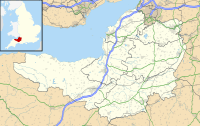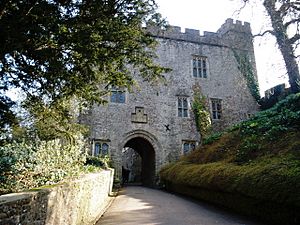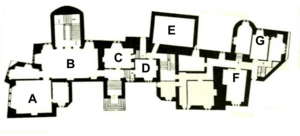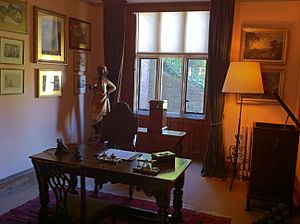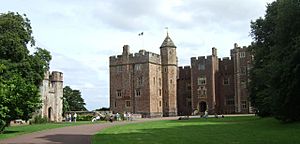Dunster Castle facts for kids
Quick facts for kids Dunster Castle |
|
|---|---|
| Dunster, Somerset, England | |
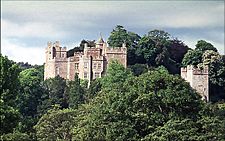
Dunster Castle
|
|
| Coordinates | 51°10′51″N 3°26′42″W / 51.1809°N 3.4449°W |
| Grid reference | grid reference SS991434 |
| Type | Motte and bailey castle, later fortified manor house and country house |
| Site information | |
| Owner | National Trust |
| Open to the public |
Yes |
| Site history | |
| Materials | Red sandstone |
| Events | The Anarchy, English Civil War, the Glorious Revolution |
Dunster Castle is a historic country house that was once a mighty castle. It is located in the village of Dunster in Somerset, England. The castle sits on a steep hill called the Tor, which has been a fortified spot since the time of the Anglo-Saxons.
The first castle was built of wood after the Norman Conquest of England in the 11th century. It was a motte and bailey castle, which means it had a raised mound (the motte) and a walled courtyard (the bailey). A stone fort was built on the mound in the 12th century. For centuries, the castle belonged to the de Mohun family and later the Luttrell family, who owned it until the late 20th century.
The Luttrell family made many changes to the castle over the years. In 1617, they built a large manor house inside the castle walls. During the First English Civil War, the castle was besieged, and afterwards, Parliament ordered its defensive walls to be torn down. In the 1860s, an architect named Anthony Salvin was hired to make the castle look more like a medieval Gothic castle, which was a popular style in the Victorian era.
In 1976, the Luttrell family gave Dunster Castle to the National Trust. Today, it is a popular tourist attraction where visitors can explore its long and fascinating history. It is protected as a Grade I listed building and a scheduled monument.
Contents
History of Dunster Castle
The First Castle
Dunster Castle is built on a tall hill that overlooks the village of Dunster. In the early Middle Ages, the sea came right up to the base of the hill, making it a strong natural defense. The first fort on the hill was an Anglo-Saxon burgh, a type of fortified town. It was built to protect the area from raids.
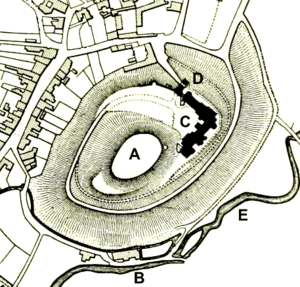
In 1066, the Normans invaded England. A Norman nobleman named William de Mohun was given lands in Somerset. He built the first castle at Dunster around 1086. It was a wooden motte and bailey castle, built on top of the old Anglo-Saxon fort. The top of the hill was shaped into the motte, and the area below became the bailey.
The castle helped to control the area and guard the coast. Stone walls were added in the early 12th century, creating a stronger fort called a shell keep on top of the motte.
During a civil war known as the Anarchy in the 1130s, the castle's owner, also named William de Mohun, supported Empress Matilda. King Stephen's forces attacked the castle in 1138 but could not capture it. William was a powerful lord who controlled the region from his strong castle.
A Grand Family Home
In the 13th century, the Lower Ward (the bailey) was rebuilt with stone walls. A survey in 1266 described the castle as having a hall, kitchen, chapel, and a knight's hall, all protected by towers.
In 1376, the de Mohun family sold the castle to the Luttrell family. The Luttrells would own Dunster for the next 600 years. When Sir Hugh Luttrell took over in 1404, the castle needed repairs. Between 1419 and 1424, he built the impressive Great Gatehouse that still stands today. It was made of red sandstone and served as a grand entrance.
By the 15th century, the sea had moved away from the castle. The Luttrells created a deer park nearby, which was a sign of wealth and provided them with meat from hunting.
In 1617, George Luttrell decided to build a comfortable new house inside the castle walls. He hired the architect William Arnold to design a grand Jacobean mansion. This new home was stylish and elegant, with decorative plaster ceilings. It cost over £1,200, a huge amount of money at the time.
The English Civil War
When the First English Civil War broke out in 1642, the Luttrell family supported Parliament. The castle was attacked by Royalist forces but they failed to take it. However, in 1643, the Royalists gained control of the south-west, and the Luttrells switched their support to the King. The future King Charles II even stayed at the castle in 1645.
Later that year, Parliament's army, led by Colonel Robert Blake, laid siege to Dunster. The siege lasted for months. By April 1646, the Royalists had to surrender.
After the war, Parliament ordered that the defenses of many castles should be destroyed to prevent them from being used again. This was called slighting. The owner, George Luttrell, persuaded Parliament to only destroy the medieval defensive walls, saving his family home. In 1650, the walls were torn down, leaving only the Great Gatehouse and the bases of two towers.
A Fashionable Mansion
In the 1680s, Francis Luttrell and his wealthy wife, Mary Tregonwell, modernized the house. They added a grand staircase and other fashionable features.
During the 18th century, the castle continued to be updated. A new chapel was built, and a new, easier road to the castle called the New Way was created. The top of the motte was flattened to make a bowling green with a small summer house.
From 1747, Henry Fownes Luttrell and his wife Margaret redecorated the castle in the popular Rococo style, using fashionable wallpapers. They also raised the ground level of the Lower Ward to improve the entrance to the mansion. To improve the view from the castle, they built a tower called Conygar Tower on a nearby hill.
Victorian Makeover
In 1867, George Luttrell inherited the castle. During the Victorian period, it was popular to remodel old castles to look more romantic and Gothic. George hired the famous architect Anthony Salvin to transform Dunster.
Between 1868 and 1872, Salvin made huge changes to the castle's appearance. He added large towers to make the building look more impressive and less symmetrical. He also installed modern technology like running water, gas lighting, and central heating.
Inside, Salvin created new rooms, including a large Outer Hall, a library, and a billiard room. The goal was to make the castle look as if it had grown naturally over many centuries, while also making it a comfortable home for a wealthy 19th-century family.
The 20th Century and the National Trust
Alexander Luttrell inherited the castle in 1910 but chose to live elsewhere. His son, Geoffrey, moved back in 1920. During World War II, the castle was used as a recovery home for injured naval officers.
After Alexander's death in 1944, the family faced high death duties (a tax on property left by someone who has died). In 1949, Geoffrey Luttrell had to sell the castle and its lands, though he continued to live there as a tenant. He was able to buy the castle back in 1954.
In 1976, his son, Colonel Sir Walter Luttrell, gave Dunster Castle and most of its contents to the National Trust. This ensured that the historic building would be preserved for everyone to enjoy.
Dunster Castle Today
Today, Dunster Castle is a popular tourist attraction run by the National Trust. While little of the medieval castle remains, visitors can see the 13th-century gates and the impressive 17th-century manor house that was remodeled by the Victorians.
Inside, you can see important art, including a famous portrait of Sir John Luttrell and beautiful leather tapestries. The castle's gardens cover about 6 hectares and include a national collection of Strawberry Trees.
The National Trust continues to care for the castle. In 2008, solar panels were installed on the roof to generate clean energy. In 2016, the 19th-century underground water reservoir was opened for the public to see.
See also
- Grade I listed buildings in West Somerset
- List of National Trust properties in Somerset
- Castles in Great Britain and Ireland
- List of castles in England


